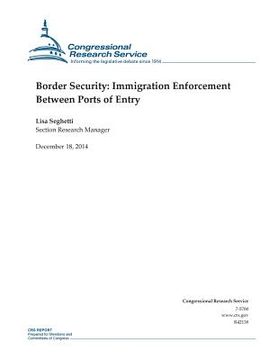Synopsis "Border Security: Immigration Enforcement Between Ports of Entry (in English)"
Border enforcement is a core element of the Department of Homeland Security's effort to control unauthorized migration, with the U.S. Border Patrol (USBP) within the U.S. Customs and Border Protection (CBP) as the lead agency along most of the border. Border enforcement has been an ongoing subject of congressional interest since the 1970s, when illegal immigration to the United States first registered as a serious national problem; and border security has received additional attention in the years since the terrorist attacks of 2001. Since the 1990s, migration control at the border has been guided by a strategy of "prevention through deterrence"-the idea that the concentration of personnel, infrastructure, and surveillance technology along heavily trafficked regions of the border will discourage unauthorized aliens from attempting to enter the United States. Since 2005, CBP has attempted to discourage repeat illegal migrant entries and disrupt migrant smuggling networks by imposing tougher penalties against certain unauthorized aliens, a set of policies eventually described as "enforcement with consequences." Most people apprehended at the Southwest border are now subject to "high consequence" enforcement outcomes. Across a variety of indicators, the United States has substantially expanded border enforcement resources over the last three decades. Particularly since 2001, such increases include border security appropriations, personnel, fencing and infrastructure, and surveillance technology. In addition to increased resources, the USBP has implemented several strategies over the past several decades in an attempt to thwart illegal migration. Recently, the Obama Administration announced executive actions to "fix" the immigration system. These actions address numerous issues, including a security plan at the southern border. The Border Patrol collects data on several different border enforcement outcomes; and this report describes trends in border apprehensions, recidivism, and estimated got aways and turn backs. Yet none of these existing data are designed to measure illegal border flows or the degree to which the border is secured. Thus, the report also describes methods for estimating illegal border flows based on enforcement data and migrant surveys. Drawing on multiple data sources, the report suggests conclusions about the state of border security. Robust investments at the border were not associated with reduced illegal inflows during the 1980s and 1990s, but a range of evidence suggests a substantial drop in illegal inflows in 2007-2011, followed by a slight rise in 2012 and a more dramatic rise in 2013. Enforcement, along with the economic downturn in the United States, likely contributed to the drop in unauthorized migration, though the precise share of the decline attributable to enforcement is unknown. Enhanced border enforcement also may have contributed to a number of secondary costs and benefits. To the extent that border enforcement successfully deters illegal entries, such enforcement may reduce border-area violence and migrant deaths, protect fragile border ecosystems, and improve the quality of life in border communities. But to the extent that aliens are not deterred, the concentration of enforcement resources on the border may increase border area violence and migrant deaths, encourage unauthorized migrants to find new ways to enter illegally and to remain in the United States for longer periods of time, damage border ecosystems, harm border-area businesses and the quality of life in border communities, and strain U.S. relations with Mexico and Canada.

